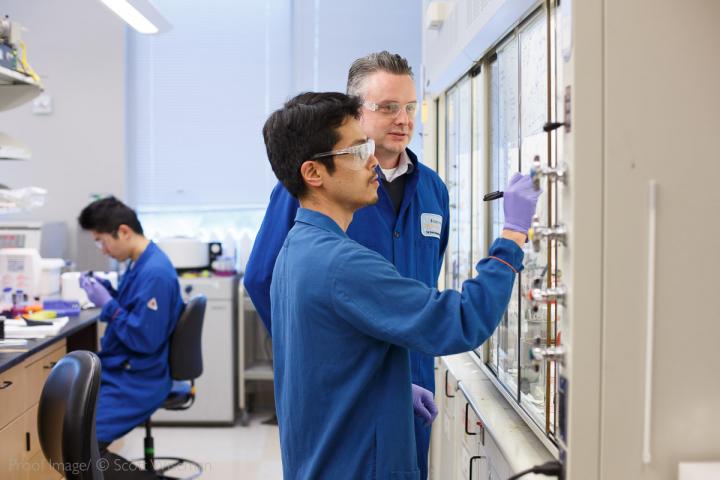
Credit: Courtesy of Scripps Research
JUPITER, FL – Since the ice bucket challenge went viral in 2014, raising awareness and funding for ALS research, scientists have learned much about a disease that disconnects muscles from nerves, leading to muscle atrophy and eventual death. Their ultimate goal is to create medications capable of stopping ALS in its tracks.
Writing in the journal Cell Chemical Biology, Scripps Research chemist Matthew Disney, PhD, and colleagues describe a new compound that blocks the most common genetic cause of both familial ALS and frontotemporal dementia. Disney’s group is assessing its potential to become a drug to treat both these diseases.
“Hopefully, this will be an accelerant not only for us but for all people in the field working toward a treatment for ALS,” Disney says.
The compound works differently than most drugs on the market. Rather than binding with the toxic protein behind the disease, it binds with what’s involved in making the protein, a specific form of RNA folded over like a hairpin. Since RNA molecules manage the expression of genes, intervening at the RNA level goes right to the apparent cause of that form of the disease, Disney says.
“There are zero therapies that address the root cause of this disease,” Disney says. “Zero. Our goal is not to target the symptoms, it is to target the root cause, which is that RNA.”
ALS, short for amyotrophic lateral sclerosis, is also known as Lou Gehrig’s disease in honor of the late baseball legend. An estimated 20,000 people in the United States currently live with the neurodegenerative disorder, including former professional football player Tim Green, who recently announced his illness on 60 Minutes.
There are likely multiple causes of ALS. For an estimated 1 in 10 people with ALS, it runs in the family. Around a third of them appear to have inherited the type of DNA damage that Disney’s compound targets.
The damaged DNA lies in a non-coding section of the 9th chromosome. There, a stutter-like repeat of letters GGGGCC prompt the cell’s protein building machinery to start production of a toxic substance, C9RAN. Disney credits his collaborator, Leonard Petrucelli of the Mayo Clinic in Jacksonville, FL, with co-discovery of the cause. That toxic substance appears to disrupt the nerve cell’s normal metabolism, leading to its death, Disney says.
It is the death of the nerve connectors between muscles and the brain that leads to ALS symptoms of muscle atrophy, weakness, difficulty swallowing and breathing. In frontotemporal dementia, the toxic protein appears to be a cause of neuron death in parts of the brain that control behavior and personality, the frontal and temporal lobes. Disney’s compound, a small molecule he designed, is simply referred to as “4,” in the paper. It interferes with production of the toxic C9RAN protein, he says.
One important finding of the paper is that the form of the RNA being targeted by many research groups at present may not actually be the one driving neuron death, Disney says.
“There are two different shapes of the protein. The data supports that the shape people have not been looking at is actually the toxic one,” he says.
Many questions must be answered before it’s clear that the compound “4” could serve as a drug. The research is ongoing, Disney adds.
“We have a long and winding road to make this into a drug. You have to not only show that a molecule works, but that it is safe,” he says. “Now that we have a target and we know how to bind it, this should accelerate making compounds that could become drugs in a much more streamlined way.”
###
In addition to Disney and Petrucelli, the authors of the paper, “The Hairpin Form of r(G4C2)exp n c9ALS/FTD is Repeat-associated non-ATG Translated and a Target for Bioactive Small Molecules,” are Zi-Fu Wang, Andrei Ursu, Jessica L. Childs-Disney, Rea Guertler, Wang-Yong Yang, Viachaslau Bernat, Suzanne G. Rzuczek, Rita Fuerst and Brendan G. Dwyer of Scripps Research; and Yong-Jie Zhang and Tania F. Gendron of the Mayo Clinic. Also, Ilyas Yildirim of Florida Atlantic University, and Joseph E. Rice of Rutgers University contributed.
This work was funded by the NIH (DP1 NS096898-02; P01 NS099114-01; R35NS097273, R21NS084528, P01NS084974, R01NS088689, and R01NS093865), Department of Defense (ALSRP AL130125; Mayo Clinic Foundation; Robert Packard Center for ALS Research at Johns Hopkins; Target ALS; Association for Frontotemporal Degeneration; Muscular Dystrophy Association [no. 416137]; Amyotrophic Lateral Sclerosis Association [ALSA; 15-TALS-297], Alzheimer’s Drug Discovery Foundation [ID: 2014120] and Target ALS). The Deutsche Forschungsgemeinschaft Postdoctoral Fellowship also provided support, along with gifts from Marilyn and Jay Nelson.
About Scripps Research
Scripps Research is ranked the most influential scientific institution in the world for its impact on innovation. A nonprofit research organization, Scripps Research expands basic knowledge in the biosciences and uses these fundamental advancements to develop profound innovations that improve well-being. Scripps Research scientists lead breakthrough studies that address the world’s most pressing health concerns, accelerating the creation and delivery of medical breakthroughs to better human health across the globe. The institute’s educational and training programs mold talented and committed students and postdocs into the next generation of leading scientists.
For more information about Scripps Research visit http://www.
Media Contact
Stacey Singer DeLoye
[email protected]
561-228-2551
Original Source
https:/
Related Journal Article
http://dx.




